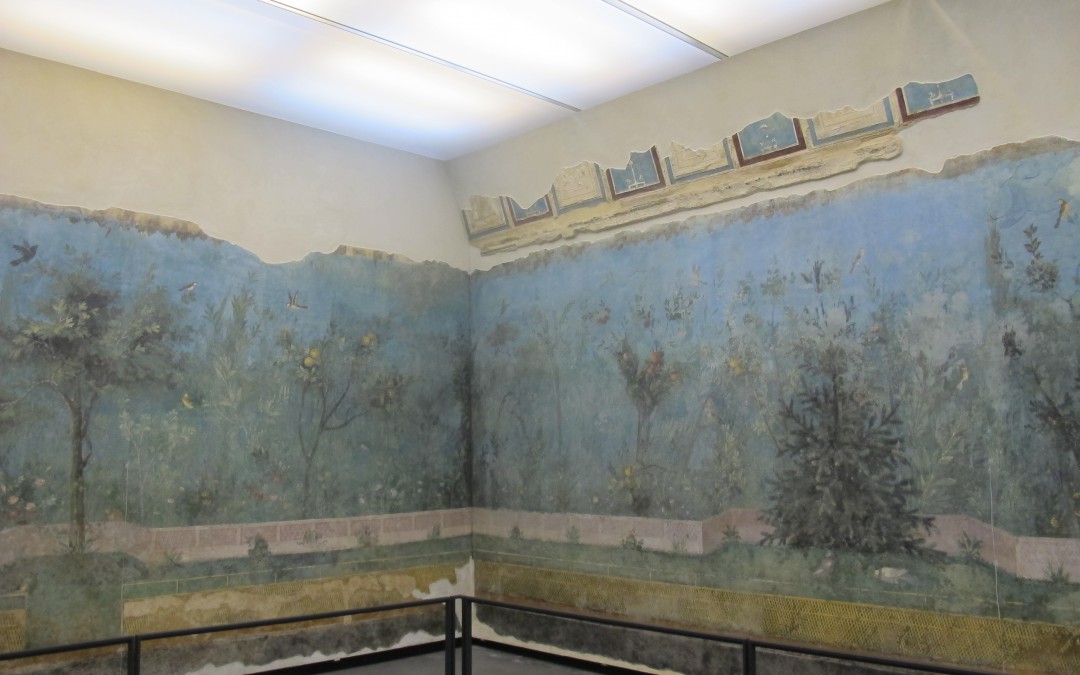In a city filled with extraordinary works of ancient art, perhaps one of the most breathtaking is one of the least visited and one of my favourites. After visiting the “Monsters” exhibition (excellent, go) at Palazzo Massimo today I went to the top floor to say hello to the dining room of Livia, wife of the Emperor Augustus.

Triclinium paintings from the villa of Livia at Prima Porta, Museo Nazionale Romano, Palazzo Massimo alle Terme
The room was discovered at the Villa of Livia ad gallinas albas (by the white hen) in the area now known as Prima Porta on 30th April of 1863, just ten days after the celebrated statue of Augustus had also been found close by. The existence and location of the villa is well-documented, amongst others by Pliny and Cassius Dio. They tell us that its name came from a white hen which fell, alive, from the clutches of an eagle into Livia’s lap. The hen, it is said, held a branch of laurel in its beak which was planted and grew with such vigour that it would provide the wreaths for the triumphs of generations to come.
The report of the Pontifical Ministry of Public Works (Rome was still, just, under papal control) recorded that a room
“with painted walls in good condition representing fruit trees and flowers with various birds. The ceiling had entirely collapsed and the stucco decoration which once decorated the vault was found among the rubble which filled the room.”
Such was the state of disrepair of the site that in 1951 the drastic decision was taken to detach the frescoes, and in 1998 they found their way to their present collocation in a room built to the dimensions of the original.
Painted c. 30-20 BC, Livia’s triclinium (dining rooms were so called for the couches arranged in groups of three) was partially underground, a common setting for rooms which were to be used in the scorching summer months. Instead of looking out onto the real gardens of the villa, a garden of the imagination was painted on its walls, just beyond a painted perimeter wall.
The scene is a natural impossibility: fruiting pomegranates and quinces jostle with flowering irises and camomile; palms, pines, and oaks flourish while partridges, doves, and goldfinches feast on their fruit and rest on their branches. Only one bird does not fly free, enclosed in a gilded cage resting on the low wall.
The scene is one of timeless and exotic fecundity; each species frozen in its own moment of glory. We are, the painting tells us, ensconced in the perpetual spring of the glorious reign of Augustus.
A guided tour of Palazzo Massimo would offer a wealth of riches for anyone interested in deepening their understanding of Imperial Rome. It could also be combined with other sites on the Esquiline Hill, such as what remains of the Baths of Diocletian.
National Roman Museum
Palazzo Massimo alle Terme
Largo di Villa Peretti
Tues – Sun 9am – 6pm
10 euros






My husband and I also visited this reproduction of the triclinium and found the beautiful garden frescoes enchanting, as well as the realization that we were enjoyng the same scenes enjoyed by Livia and Augustus Ceasar. There was a tapestry in the museum store of a detail of the fresco, which I wanted to purchase, but didn’t, and now I can’t locate it on the internet. Anyone have an idea how to obtain one?
I am happy that this room is not as visited as other sites in Rome. I always enjoyed just the calm setting of the room in the museum, few people bother to enter into it not understanding what they are looking at.
I understand the Livia murals are open limited hours. Can anyone tell me what days/times I could,see them?
Thank you!
Today, after many years of trying to see this room, and failing, we succeeded. Glorious is the first word that comes to mind. I love this room more than most of the art of the time period. We sat alone in that space for a long time. As we sat and wondered, I felt I knew something about Livia. This is my new favorite spot in Rome.
My friend and I visited Paris and stayed a while in the Musee de l’Orangerie room surrounded by Monet’s Water Lilies. Two days later we were in Livia’s Room in Rome, and seeing the two places in such proximity was utterly glorious, one of my favorite “lagniappes” in my whole life.